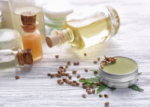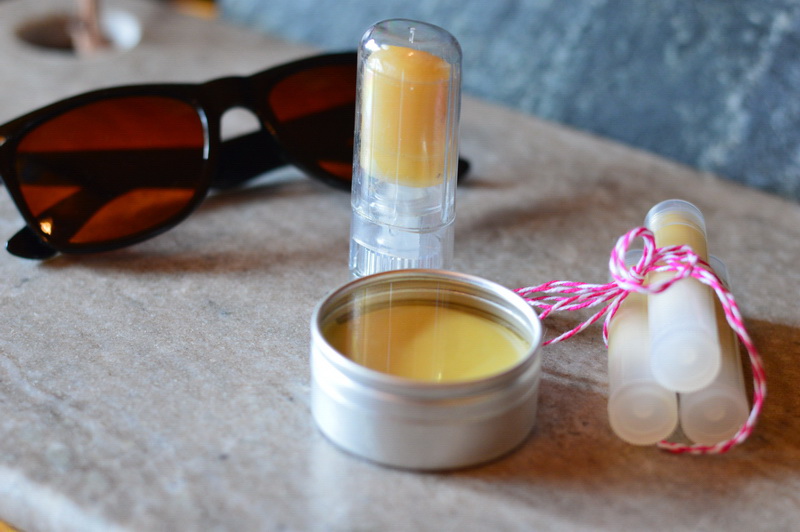It’s not something many of us think about making at home, but homemade sunscreen made with natural ingredients is nourishing and protects the skin from the ravages of the summer sun. Here’s how to make sunscreen at home.
Summer vacation means time at the beach, in the garden, and at the park. The commercials and warnings have already started. We’re told to wear sunscreen to protect against skin cancer. And many of us dutifully pick up a new bottle of SPF 30 or even SPF 50 expecting that it will solve the problem and let us live in the sun for the summer.
However, even with commercial SPF ratings, they only increase the time you can spend in the sun before burning occurs. They don’t completely prevent burning, and they do disrupt our body’s natural vitamin D production. Natural sunscreens that focus on anti-oxidant effects of natural ingredients don’t change our sun exposure, but do protect our skin from the sun’s oxidization and still let us produce natural vitamin D.
But non-toxic homemade sunscreen is better.
What’s wrong with OTC Sunscreen?
Commercial, over-the-counter sunscreen products are pricey. Plus they feel gross on your skin so it’s hard to get your family to use them.
Commercial sunscreen also contains toxic and carcinogenic ingredients like retinyl palmitate (a synthetic form of vitamin A that encourages malignant cells to develop), PABA, and oxybenzone, a hormone disrupting chemical that is absorbed through the skin. Oxybenzone is highly toxic to coral reefs and other marine life.
UVA and UVB
The sun has two kinds of radiation that we are concerned about when choosing a sunscreen: UVA radiation, sometimes just referred to as UV radiation, and UVB radiation. UVA radiation is steady during all daylight hours. It’s the deeply penetrating radiation that causes free radical damage and premature aging. UVB radiation is strongest between 11am and 1pm on sunny days. It’s the radiation that allows your skin to produce vitamin D. It’s also the radiation that gives you a suntan or a sunburn.
Most commercial sunscreens block only the UVB radiation. In fact, using these sunscreens inhibits the absorption of vitamin D by your body. At the same time, most sunscreens allow UVA rays to get through the barrier. UVA rays penetrate deeply into the tissue, below the skin, causing free radical damage, which can lead to premature aging and even skin cancer. Vitamin D can also help prevent free radical damage, but the reduction in Vitamin D production can also increase the chance of skin damage.
And since UVA rays don’t cause sunburn, the damage may not be noticed until it’s too late. The SPF of any sunscreen product only measures the UVB blocking ability of the sunscreen, not the UVA blocking qualities. Which means, even with commercial products, your skin may not be as protected as you think.
For protection from UVA rays sunscreen needs to include either titanium dioxide or zinc oxide, in a non-nano form. Nano particles may be absorbed into your skin. Non-nano zinc or titanium remains on the surface of your skin, where it can provide broad spectrum sun protection. Zinc or titanium work by both absorbing and scattering UVA and UVB radiation.
For a sunscreen to be broad spectrum it should include either titanium dioxide or zinc oxide. Of the two, zinc oxide has been found to be more beneficial in blocking UVA radiation than titanium. If you want a solid wide range blocking diy sunscreen, including non-nano zinc oxide or titanium will be very beneficial. You may also be able to find some small-batch semi-commerical mineral sunscreens that will be equally helpful.
Should you skip sunscreen?
Some folks suggest skipping sunscreen entirely. This may be an option if you have a diet that is high in organic fruit and vegetables, especially high antioxidant fruits, and you don’t have a job that puts you out in the sun all day. Fruit and vegetable consumption increases the antioxidants in your body and helps your body deal with circulating free radicals that might cause damage to your cells.
I have noticed a difference in the frequency of sunburn with eating lots of fresh vegetables, and lots of antioxidant fruit. Mr. Joybilee is a fair skinned, red head who used to burn regularly with even a small amount of sun exposure. More recently, the burning has decreased, despite age increasing, as our diet is more and more drawing from healthy, healing, plants, fruits, vegetables, and herbs. However, we still use our homemade sunscreen if we’re going to be out in the garden for more than thirty minutes, though admittedly sometimes thirty minutes does turn into an hour or more.
But those with fair skin, those who work outside or spend time in the garden for long hours, and those with a less than adequate diet will benefit from using sun protection outside. Those under 18 should also be protected when they are out in the sun. Skin that is repeatedly damaged by sunburn is more susceptible to skin cancer later in life. It is a simple reality that continuous damage does increase the chance of cells mutating wrong, at least with our skin. However, taking charge of our own health is always a good plan.
DIY Sun Protection
Wide brim hats and long sleeved shirts can help protect you from solar radiation. Cotton fabrics provide a sun protection factor (SPF) of 15. Linen is another great summer option, as many linen garments are loose and flowing allowing for both airflow, and sun protection. Another option is homemade sunscreen, using herbs and natural ingredients. Natural herbal oils are rich in antioxidants. They not only protect, but they also help your body with its job of repairing at a cellular level. Things like coconut oil, carrot seed oil, and even rosehip seed oil can be beneficial in sunscreen for their skin repair factors, as well as their mild SPF qualities.
This recipe for homemade sunscreen takes advantage of the natural SPF values and antioxidant qualities of natural oils, beeswax, and butters. Lavender, calendula, raspberry seed oil, and vitamin E are high in antioxidants to repair free radical damage.
The addition of zinc oxide is optional. Add it if you are spending a long time in the sun or you need a broad spectrum sunscreen to protect from both UVA and UVB damage. Homemade sunscreen is oil based, so it will wear off with water exposure but won’t be water soluble.
Print
Homemade Sunscreen
Description
A simple diy sunscreen recipe, to help you stay safe this summer
Ingredients
- 2 tablespoon beeswax
- 2 tablespoon shea butter
- 2 tablespoon calendula infused* virgin olive oil
- 1 tablespoon hempseed oil
- 1 tablespoon red raspberry seed oil
- 1 teaspoon vitamin E, natural source
- 25 drops lavender essential oil
Optional:
-
- 1 tbsp. zinc oxide, non-nano to increase the spf to 20
- or
- 1½ tbsp. zinc oxide, non-nano to increase the spf to 30.
Instructions
- Using a double boiler, melt the beeswax and shea butter in a glass jar, set in water.
- Stir to combine the beeswax and shea butter. Add calendula infused oil, and hempseed oil to the jar.
- Continue to heat and stir until the beeswax mixture combines with the oils.
- Stir in raspberry seed oil and vitamin E. Stir to combine. Remove from heat as soon as the mixture liquifies.
- Without the addition of zinc oxide this homemade sunscreen recipe has a natural spf of about 15 and offers protection from UVB radiation only.
To create a broad spectrum sunscreen and increase the spf, add zinc oxide to the recipe.
- While beeswax and shea butter are melting, stir zinc oxide powder into the oils with a spoon.
- Once the zinc oxide powder is moistened, use a stick blender to combine fully. Use a dust mask and gloves to protect from zinc oxide inhalation.
- Pour the sunscreen mixture into a 4 oz glass jar or tin and label. For a handy sunscreen stick, you can pour the liquid into lip gloss tubes.
Ingredients
- 2 tablespoon beeswax
- 2 tablespoon shea butter
- 2 tablespoon calendula infused* virgin olive oil
- 1 tablespoon hempseed oil
- 1 tablespoon red raspberry seed oil
- 1 teaspoon vitamin E, natural source
- 25 drops lavender essential oil
Optional:
- 1 tbsp. zinc oxide, non-nano to increase the spf to 20
- or
- 1½ tbsp. zinc oxide, non-nano to increase the spf to 30.

Instructions
- Using a double boiler, melt the beeswax and shea butter in a glass jar, set in water. To make a double boiler, place a small pot on the stove, with a canning jar ring in it to support a glass jar. Use the glass jar to prepare the recipe.
- Stir to combine the beeswax and shea butter. Add calendula infused oil, and hempseed oil to the jar.
- Continue to heat and stir until the beeswax mixture combines with the oils.
- Stir in raspberry seed oil and vitamin E oil, Stir to combine. Remove from heat as soon as the mixture liquifies.
- Without the addition of zinc oxide this homemade sunscreen recipe has a natural spf of about 15 and offers protection from UVB radiation only.
To create a broad spectrum sunscreen and increase the spf, add zinc oxide to the recipe.
- While beeswax and shea butter are melting, stir zinc oxide powder into the oils with a spoon.
- Once the zinc oxide powder is moistened, use a stick blender to combine fully. Use a dust mask and gloves to protect from zinc oxide inhalation.
- Pour the sunscreen mixture into a 4 oz glass jar or tin and label. For a handy sunscreen stick, you can pour the liquid into lip gloss tubes.
Notes
Yield 4 oz. (125ml) – spf 15 to 30
See instructions for making calendula infused oil here.
Clean up:
Wipe out the excess oil from the jar with paper towels and discard. Then wash the jar with detergent and water. The jar and utensils should clean up easily.
You can increase the shelf life of the sunscreen by keeping the extra containers, or tubes, in the fridge or cold storage. Keep the sunscreen container or tube that you’re actively using at room temperature, however, for ease of application.
Homemade Sunscreen Variations
For a variation, you can infuse sweet almond oil, or jojoba oil with the calendula instead of olive oil. However, the other oils will absorb into your skin faster. Or use a blend of all three oils for the infusion. The calendula is a great skin healing herb, and is great to include.
If you can’t use lavender oil in the sunscreen, use another mild essential oil like rose geranium, chamomile essential oil, or rosemary or thyme. Avoid phytosensitive oils, many citrus oils are phytosensitive and should be avoided for sun-related skin care, as they can hyper sensitize skin to the sun.
Learn More About Salves and Lotion Making

Grab my free ebook and learn to make DIY herbal healing salves at home now, with 14 easy-to-follow recipes that use the herbs and wild plants growing close to home. Salve-making is one of the easiest skills to learn in DIY Herbalism. This sunscreen recipe is just one example of a useful salve, and this ebook contains many more useful additions to your herbal emergency kit and apothecary.





Leave a Reply